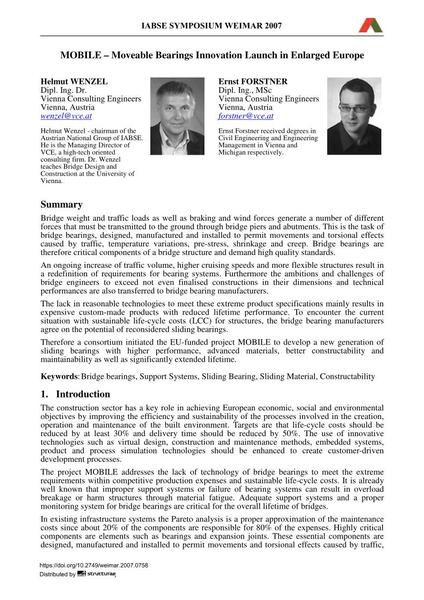MOBILE – Moveable Bearings Innovation Launch in Enlarged Europe

|
|
|||||||||||
Détails bibliographiques
| Auteur(s): |
Helmut Wenzel
E. Forstner |
||||
|---|---|---|---|---|---|
| Médium: | papier de conférence | ||||
| Langue(s): | anglais | ||||
| Conférence: | IABSE Symposium: Improving Infrastructure Worldwide, Weimar, Germany, 19-21 September 2007 | ||||
| Publié dans: | IABSE Symposium Weimar 2007 | ||||
|
|||||
| Page(s): | 584-585 | ||||
| Nombre total de pages (du PDF): | 4 | ||||
| Année: | 2007 | ||||
| DOI: | 10.2749/weimar.2007.0758 | ||||
| Abstrait: |
Bridge weight and traffic loads as well as braking and wind forces generate a number of different forces that must be transmitted to the ground through bridge piers and abutments. This is the task of bridge bearings, designed, manufactured and installed to permit movements and torsional effects caused by traffic, temperature variations, pre-stress, shrinkage and creep. Bridge bearings are therefore critical components of a bridge structure and demand high quality standards. An ongoing increase of traffic volume, higher cruising speeds and more flexible structures result in a redefinition of requirements for bearing systems. Furthermore the ambitions and challenges of bridge engineers to exceed not even finalised constructions in their dimensions and technical performances are also transferred to bridge bearing manufacturers. The lack in reasonable technologies to meet these extreme product specifications mainly results in expensive custom-made products with reduced lifetime performance. To encounter the current situation with sustainable life-cycle costs (LCC) for structures, the bridge bearing manufacturers agree on the potential of reconsidered sliding bearings. Therefore a consortium initiated the EU-funded project MOBILE to develop a new generation of sliding bearings with higher performance, advanced materials, better constructability and maintainability as well as significantly extended lifetime. |
||||
| Mots-clé: |
translateur appuis de ponts
|
||||
